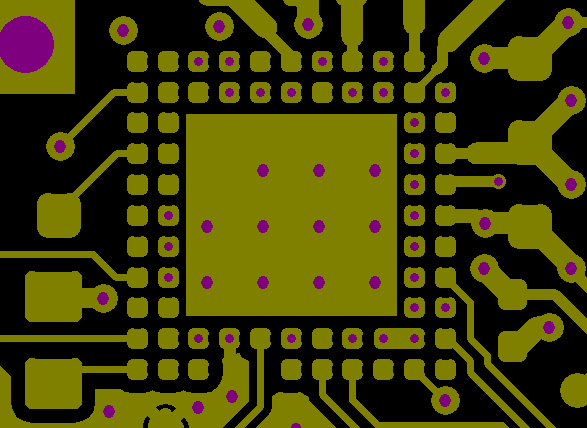The effect of via in pad on voids_Shenzhen Fitech

The effect of via in pad on voids
In PCB design, a via is a common connection that connects different layers of wiring or provides a location for components to be soldered. There are various types of via, one of which is the via in pad (via in pad), i.e., the via is punched on the SMD or BGA pads, and then the holes are plugged with resin and plated with a layer of copper on the surface, making the holes invisible on the pads.

Figure 1. Via in pad for BGA pads
Vid in Pad is the basic structure of the HDI (High Density Interconnect) board, the advantages are obvious: reduce the distance between the board and the signal transmission distance, to reduce the signal interference and loss is beneficial; plating filled with copper solid holes can effectively reduce the parasitic signals within the holes and parasitic inductance, which is conducive to the transmission of high-frequency signals; effectively reduce the thickness of the finished product board, to increase the density of cabling per unit area, and so on.
But the hole in the disc also has some disadvantages, such as high cost, long production cycle, easy to produce bubbles and so on. One of the most serious problems is the void, i.e., the bubble or gap formed inside the solder joint. Voids can affect the mechanical strength and thermal conductivity of the solder joint, leading to poor or failed soldering. Therefore, care needs to be taken to avoid or minimise the creation of voids when designing and manufacturing holes in discs.
1. Inadequate or uneven resin plugging. Resin plugging is one of the key processes for hole-in-disk, which requires the aperture to be completely filled and cured to prevent solder paste from flowing into the aperture. Inadequate or uneven resin plugging can result in trapped air inside the hole or gaps caused by shrinkage of the resin. These spaces can be filled with solder paste during soldering and form voids.
2. The plating cap is not flat or firm. Plating cap is in the resin after plugging holes in the pad surface plated with a layer of copper to increase the soldering area and wettability. If the plating cap is not flat or not firm, will lead to solder paste and copper layer between the gap or separation phenomenon, these gaps or separation will also form a hole.
3. The solder paste itself contains oxygen or other impurities. Solder paste is used to connect components and PCB metal materials, it usually contains a certain proportion of flux and other additives. These fluxes and additives at high temperatures will have a chemical reaction or volatilisation, producing oxygen or other gases.
4. Inappropriate soldering temperature. Soldering temperature is an important factor affecting the fluidity and wettability of solder paste. If the temperature is too high or the heating time is too long, it will lead to excessive oxidation or volatilisation of the solder paste, generating a large amount of gas; if the temperature is too low or the heating time is too short, it will lead to poor fluidity or solidification of the solder paste too quickly, preventing the gas from being discharged.
1. Optimise the resin hole plugging process. Resin hole plugging process needs to control the type of resin, viscosity, temperature, pressure, time and other parameters to ensure that the resin can fully and uniformly fill the holes, and does not produce shrinkage or cracking after curing.
2. Optimise the plating cap process. Plating cap process needs to control the composition of the plating solution, temperature, concentration, current, time and other parameters to ensure that the plating layer can be flat and firmly covered in the pads, and with the resin and the substrate has good adhesion. At the same time, it is necessary to choose a suitable copper reduction method to remove excess copper and keep the surface flat.
3. Select and use the appropriate solder paste. The selection and use of solder paste need to consider its match with the components and PCB, wettability, oxidation, volatility and other characteristics to reduce the generation of gas and residue.
4. Optimise soldering temperature and time. Soldering to choose the appropriate reflow temperature and time to ensure that the paste is fully wetted and flowing.
Shenzhen Fitech can produce high-quality, high-performance, high-reliability solder paste for a variety of PCB design and manufacturing processes, including hole-in-disk, microvia and so on.

















 Back to list
Back to list



